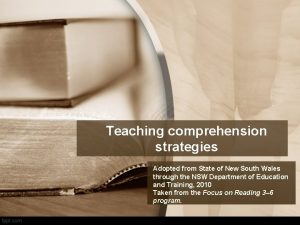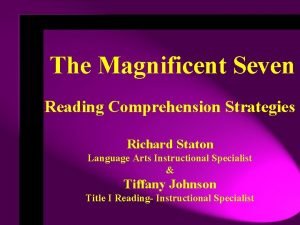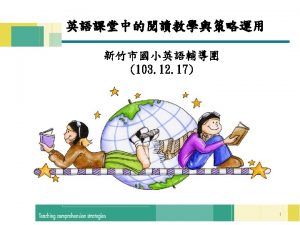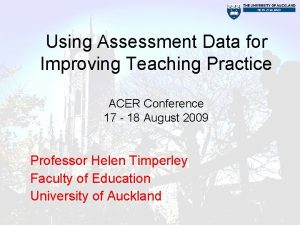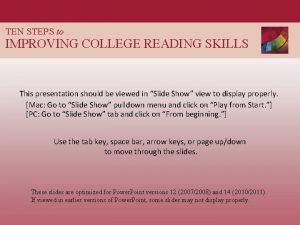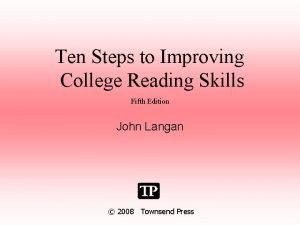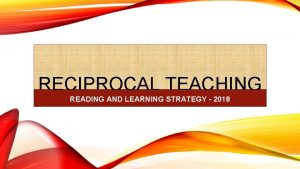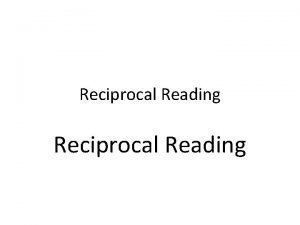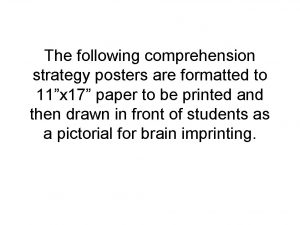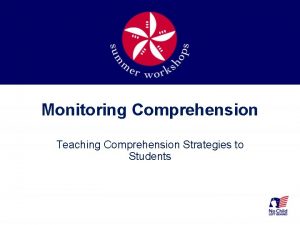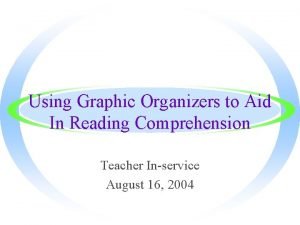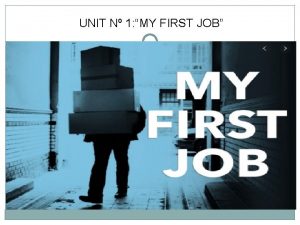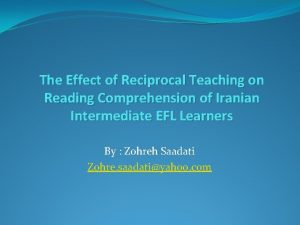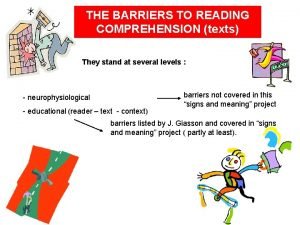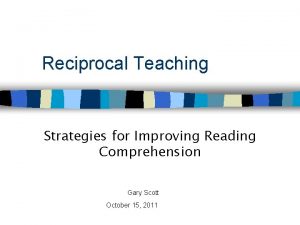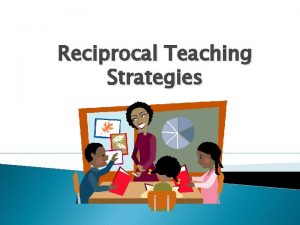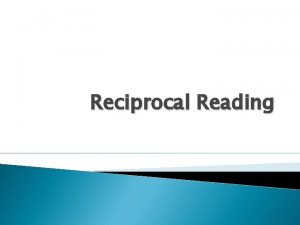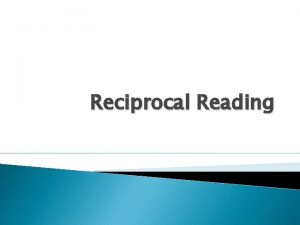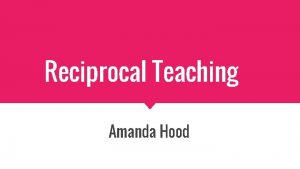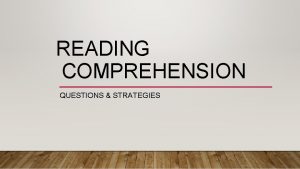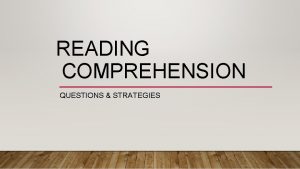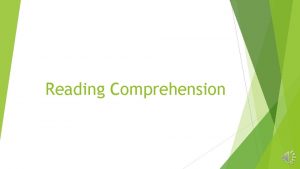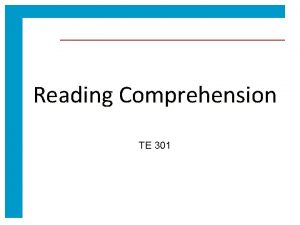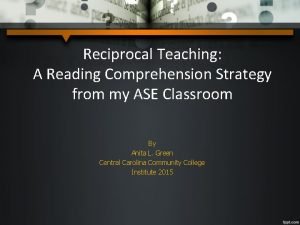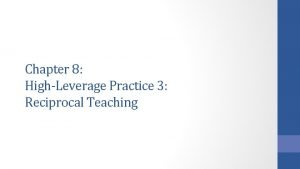Reciprocal Teaching Strategies for Improving Reading Comprehension http


















- Slides: 18

Reciprocal Teaching Strategies for Improving Reading Comprehension http: //www. sciencenewsforkids. org/category/atom s/ Gary Scott September 29, 2012

Reading and Mathematics

What the Research Says About Reciprocal Teaching n n n Palincsar and Brown 1986 when reciprocal teaching was used for just 15 days students reading increases from 30 - 80%. According to a study by Palinscar and Klenk 1991, students not only improved their comprehension skills immediately, but they also maintained improved comprehension skills when tested a year later. Lubliner 2001 points out that reciprocal teaching is an effective teaching technique that can improve on the kind of reading comprehension that is necessary not only for improved test scores but also for an information age.

What is Reciprocal Teaching? • • • RT is a framework for teaching the skills necessary for good comprehension. It is dialogue based. Initially, the teacher acts as the facilitator - modeling the use of 5 key strategies to the pupils. Gradually, with teacher support, pupils confidence and competency will increase and adult input will decrease. The eventual aim is that the pupils will be able to work independently.

Reciprocal Teaching is powerful researched based technique. It is NOT a stand alone method for teaching comprehension. n Previewing n n Self Questioning n Knowing How Words Work Monitoring n Making Connections n Summarizing n Modeling-Visualizing. Illustrating n Evaluating

The Five Reciprocal Teaching Strategies n n n Predicting Questioning Clarifying Modeling-Visualizing. Illustrating Summarizing

But don’t I use these five strategies already? n n n Most likely, you already teach your students to predict, question, clarify, summarize and visualize. The difference with reciprocal teaching is that the strategies are delivered as a multiple-strategy package used in concert with one another rather than as separate strategies. The aim of reciprocal teaching is for good readers to cycle through five strategies, not necessarily in order, to make sense of the text.

Are there any common problems that students experience with teaching reciprocal teaching? n n n Predicting: Students may not make logical predictions based on clues from the text or their experiences. Questioning: Students may only generate literal questions and may need modeling toward asking inferential or main idea questions. Clarifying: Students may initially clarify only difficult, new, or confusing words because students rarely recognize they are having trouble with an idea in the text. Modeling/visualizing: Students may focus on realworld objects, phenomena, or actions and struggle with representing them in some limited ways (e. g. , through highlighting, simplifying, showing specific aspects, adding clarifying symbols, or creating multiple representations). The main focus is still on the model and the reality modeled, not the ideas portrayed per se. Further, tests of the model are not thought of as tests of underlying ideas but of the workability of the model itself. Summarizing: Students may miss points or supply a summary that is too long, too short or a word by word rendition.

Reciprocal Teaching: Instructional Strategies Before Reading n Determine stopping points in the text for applying comprehension strategies and discussing the text. n Activate students’ background knowledge about topic or theme. n Preview the texts title, illustrations, headings, tables, etc. n Teacher models predicting and invites students to predict. Record predictions on the reciprocal teaching graphic organizer. n Remind students to think about questions to ask and to look for words and passages to clarify. You may provide sticky notes for this.

Reciprocal Teaching: Instructional Strategies During Read the text together: teacher read-aloud, choral reading, whisper reading in small groups, or silent reading. Students develop questions and identify words and passages for clarifying.

Reciprocal Teaching: Instructional Strategies After Reading Return to predictions. Teacher models how to check predictions. Teacher and students check the other predictions. Teacher models clarifying and invites students to share words and passages that need clarifying. Teacher models question asking and invites students to ask and discuss their questions. Teacher models the modeling process and asks students to create and modify models that explain the phenomena or concept. Teacher models summarizing or guides the students in creating a summary.

What is your best piece of advice for using reciprocal teaching? ü ü ü Model the strategies Be consistent Use the strategies several times a week

Remembering?

Predicting The predictor helps the group to identify the organizational structure of the text and to connect sections of the text to one another and to the overall text structure. The predictor could use the following prompts to help the group. Which type(s) of text structure did this most closely match? n What evidence lead you to identify that text structure? n Based on the type(s) identified, what did you predict that you would read about next? n What do you think we will read about next? Text types can usually be classified in the following ways: n n n n Descriptive Chronological Cause and effect Analytical Persuasive Compare and contrast

Clarifying The clarifier assists in identifying words, phrases, clauses, sentences, and sections of the text that may be unclear and asks members for ways in clearing up these problems. In the initial stages of implementation the clarifier may use the following prompts to help the group clear up difficulties. n n n What is still not clear to you? Lets reread what is still unclear and try rereading the section right before what was unclear. Lets chunk the text into smaller segments. For example, break complex sentences into component clauses or phrases. Lets visualize what is described in the text. If there are diagrams or pictures depicting the difficult material look at them carefully and read the captions that accompany the graphics. Also try mental visualizing using these phrases as aids, I picture …, I can see … Lets connect what we have read to things we already know from other science experiences. For instance, this is like …, this reminds me of … Lets get outside help. For instance, if it’s a word we don’t understand lets try the glossary in the text, a dictionary, or an encyclopedia.

Modeling (illustrating - visualizing) The modeler helps group members to make meaning from the graphs, illustrations, charts by clarifying the relationship between the text and the illustration. The modeler also helps to make sense of text by making a sketch or drawing depicting understanding and focusing on explaining the phenomena or concept. As the modeler you might ask the group: n Why is the illustration in the text? n How does it relate to the text? n How did your drawing illustrate the ideas and concepts in the text. n How does your drawing compare with others in your group? What is alike? What is different? n How did your illustration help you make meaning of the context of the text? n What will you add to your drawing to clarify your thinking and explain the phenomena or concept?

Questioning The questioner helps group members ask and answer all types of questions about the text. As the questioner, you might ask the group: n What questions did you have as you read? n Can anyone else help answer that question? n What kind of question was that? n What did we do to find answers? n Are there any other questions you wonder about?

Summarizing The summarizer helps group members restate the main ideas in the reading. Reminder - Summaries are formed by the reader and are not found in the text. They do not include the details. Summarizing helps us understand remember what we have read. As the summarizer you might ask the group: n What are the main ideas in this chunk of text? n Can you use your own words to state the main idea in one sentence? n Which parts could you leave out and still get the point across? n How can we combine our ideas into one summary?
 Super six comprehension strategies nsw det
Super six comprehension strategies nsw det Seven reading strategies
Seven reading strategies Super 6 comprehension strategies
Super 6 comprehension strategies Strategies for improving intercultural communication
Strategies for improving intercultural communication Using assessment data for improving teaching practice
Using assessment data for improving teaching practice Ten steps to advancing college reading skills answers
Ten steps to advancing college reading skills answers 10 steps to improving college reading skills
10 steps to improving college reading skills While reading activities
While reading activities Rt reading
Rt reading Reciprocal reading role cards
Reciprocal reading role cards Reciprocal reading
Reciprocal reading Comprehension strategies posters
Comprehension strategies posters What is comprehension monitoring
What is comprehension monitoring Reading comprehension about inventions
Reading comprehension about inventions Story maps for reading comprehension
Story maps for reading comprehension My first job reading comprehension
My first job reading comprehension Jobs and professions reading comprehension
Jobs and professions reading comprehension Define reading comprehension
Define reading comprehension What are the barriers to reading
What are the barriers to reading
